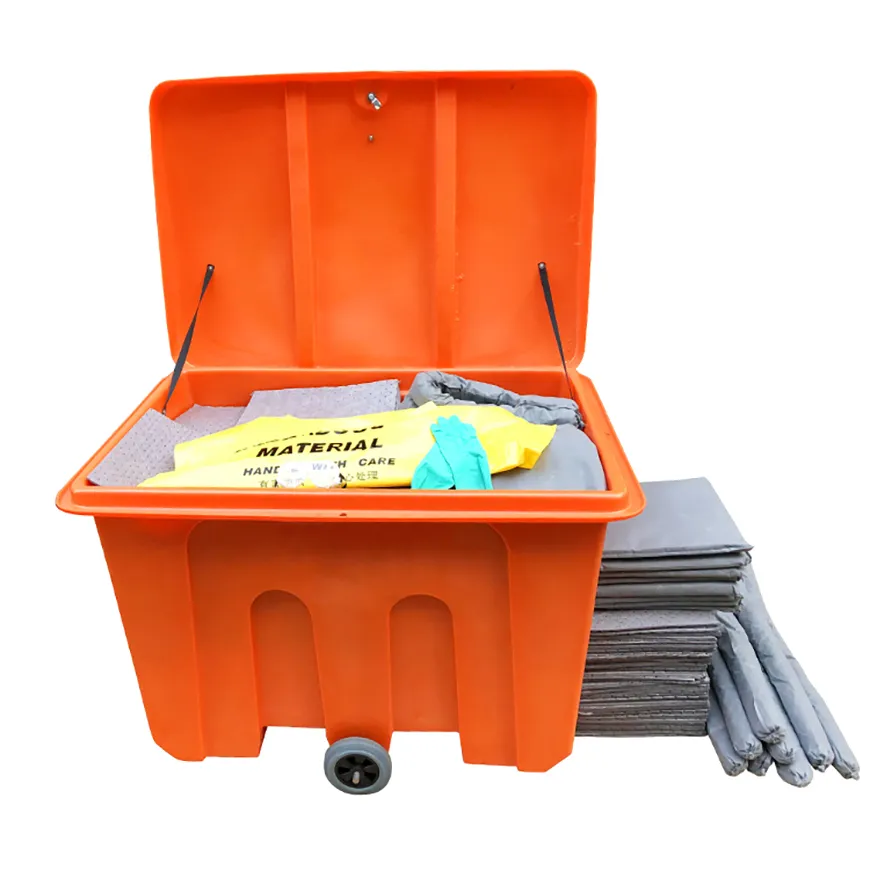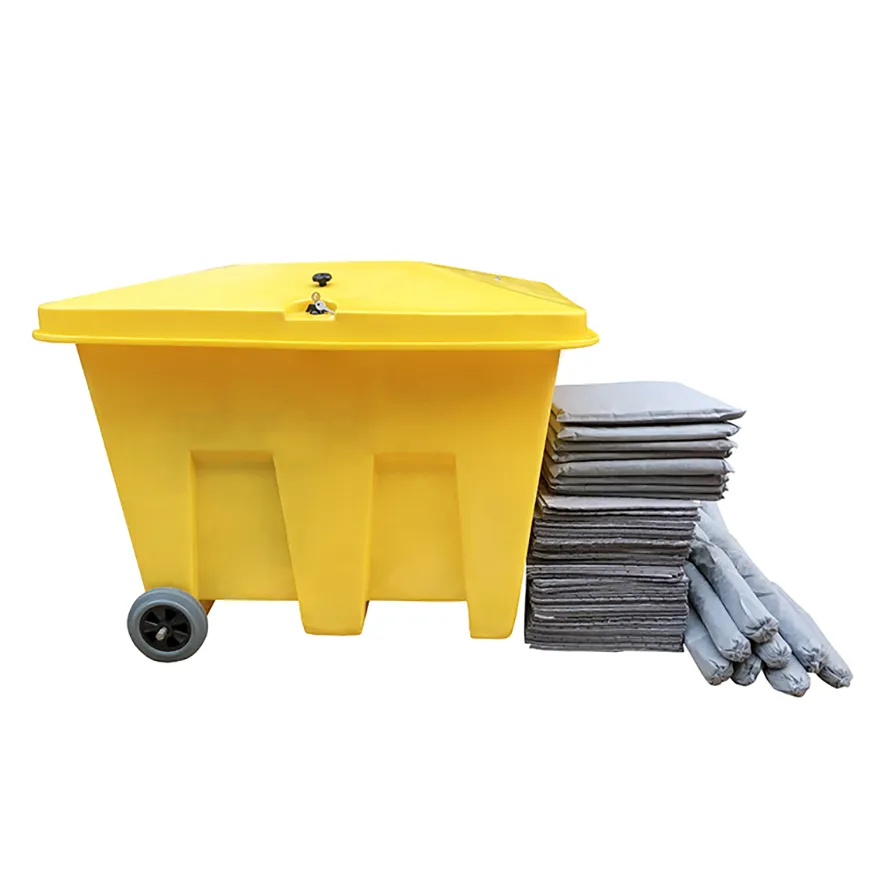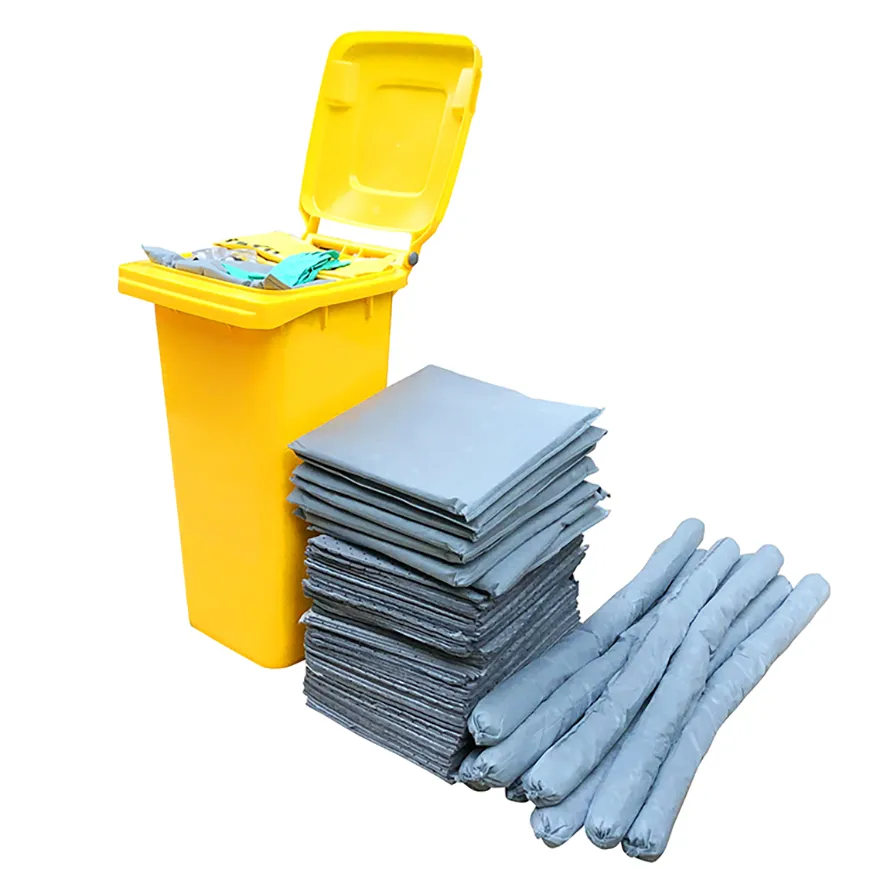
Choosing the right 55 gallon spill kit is critical for workplace safety and effective spill response. Whether you’re dealing with oil, chemicals, or universal spills, having the right spill response equipment ensures quick cleanup and minimizes risks. Factors like response time, budget, and scalability play a big role in your decision. For example, portable kits work well for emergencies in high-risk areas, while wall-mounted options suit fixed locations. So, how can you match a spill kit to your specific needs? By understanding your environment, spill risks, and compliance requirements, you can make the best choice for safety and preparedness.
Key Takeaways

Think about the spills that could happen at work. Pick oil-only, chemical, or universal kits based on what you need.
Look at your workplace setup. Check if it’s indoors or outdoors and where spills might happen to pick the right kit.
Follow the rules. Your spill kit should meet OSHA and EPA rules to stay safe and avoid fines.
Put spill kits where accidents are likely. Make sure they’re easy to see and grab quickly in emergencies.
Teach workers how to handle spills. Practice drills so everyone knows how to use the kit well.
Understanding the 55 Gallon Spill Kit
What Is a 55-Gallon Spill Kit?
A 55-gallon spill kit is your go-to solution for handling medium to large spills in industrial or commercial settings. It’s designed to help you quickly contain and clean up spills, whether it’s oil, chemicals, or other hazardous materials. The kit typically comes in a durable 55-gallon drum, making it easy to store and transport. Think of it as a safety net for your workplace, ensuring you’re prepared for unexpected spills and minimizing risks to people and the environment.
Key Components of a Spill Kit
When you open a 55-gallon spill kit, you’ll find everything you need for effective spill response. Here’s what you can expect:
100 to 200 absorbent pads for soaking up liquids.
10 to 20 absorbent socks (3″ x 48″) to contain spills and prevent spreading.
5 large pillows for absorbing larger volumes.
Safety gear like nitrile gloves and splash goggles to protect you during cleanup.
Disposal bags and ties for safe waste removal.
An instruction sheet to guide you through the process.
These components work together to make spill cleanup fast and efficient, so you can get back to work with minimal downtime.
Common Uses and Applications
You’ll find 55-gallon spill kits in a variety of industries because they’re so versatile. In manufacturing facilities, they’re essential for handling hazardous chemicals and lubricants. Construction sites use them for cleaning up sealants, paints, and fuels. Auto shops rely on them to manage oil and fluid leaks, while retail stores keep them handy for spills from cleaning chemicals or liquid products. Even truckers carry smaller versions to deal with minor spills during transport. No matter your industry, a spill kit ensures you’re ready for whatever comes your way.
Key Factors to Consider When Choosing a Spill Kit

Choosing the right spill kit isn’t just about grabbing the first one you see. You need to think about the types of spills you might face, your workplace environment, and the regulations you must follow. Let’s break it down step by step.
Identifying the Type of Spills
The first thing to consider is the type of spill you’re preparing for. Different spills require different solutions, and using the wrong kit can make cleanup harder—or even dangerous.
Oil Spills
If you’re dealing with oil spills, you’ll need an oil-only spill kit. These kits are designed to absorb oil while repelling water, making them perfect for outdoor use or near water sources. They’re ideal for industries like transportation, marine, and manufacturing where oil leaks are common.
Chemical Spills
Chemical spills require a specialized chemical spill kit. These kits include absorbents that can handle aggressive chemicals like acids and solvents. They’re a must-have for labs, factories, and any workplace handling hazardous substances.
Universal Spills
For workplaces with a mix of spill risks, a universal spill kit is your best bet. It can handle oils, coolants, solvents, and water-based liquids. This versatility makes it a great choice for general-purpose use in warehouses, workshops, and retail spaces.
Assessing Your Workplace Environment
Your workplace environment plays a big role in choosing the right spill kit. Here’s what to keep in mind:
Indoor environments often deal with chemical spills and need kits designed for these scenarios.
Outdoor settings, especially near water, require weather-resistant kits with floating absorbents.
Environmental factors like humidity and temperature can also affect how well your kit performs.
Think about where spills are most likely to happen and choose a kit that fits those conditions.
Understanding Regulatory Requirements
Regulations are another critical factor. You need to ensure your spill kit meets OSHA and EPA guidelines to stay compliant and avoid penalties. Here’s a quick overview:
OSHA Standard | Description |
|---|---|
29 CFR 1910.120 (HAZWOPER) | Requires employers to have a spill response plan and appropriate spill control equipment. |
29 CFR 1910.1200 (HazCom) | Mandates a hazard communication program, including spill response procedures. |
29 USC 654(a)(1) (General Duty Clause) | Requires a workplace free from recognized hazards, including spill risks. |
The EPA also has rules like the SPCC Rule, which focuses on preventing oil discharges into water, and the FRP Rule, which requires response plans for worst-case scenarios. Make sure your spill kit aligns with these guidelines to ensure proper spill containment and compliance.
Evaluating Spill Volume and Frequency
Worst-Case Scenario Planning
When choosing a spill kit, you need to think about the worst-case scenario. What’s the largest spill your workplace could face? Imagine a storage drum tipping over or a tank leaking its entire contents. Planning for these situations ensures you’re ready for anything. A 55-gallon spill kit is designed to handle medium to large spills, but you should confirm it matches the potential volume of spills in your facility.
Take a moment to assess your storage areas. Are you storing chemicals, oils, or other liquids in bulk? If so, calculate the maximum amount that could spill at once. This helps you determine if a single kit is enough or if you’ll need multiple kits for proper spill control. It’s always better to over-prepare than to find yourself short on supplies during an emergency.
Historical Spill Data
Your workplace’s history can tell you a lot about what to expect. Look at past incidents to identify patterns. Have you dealt with frequent small spills, or were there occasional larger ones? This data can guide your decision. For example, if small spills happen often, you might want to keep multiple kits in different locations for quick access.
Think about the types of spills you’ve handled before. Were they oil leaks, chemical spills, or a mix of both? This information helps you choose the right type of kit. Reviewing historical data also highlights areas where spills are most likely to occur, so you can strategically place your kits for maximum efficiency.
By combining worst-case scenario planning with historical data, you’ll have a clear picture of your spill response needs. This approach ensures you’re prepared for both everyday incidents and unexpected emergencies.
Comparing Types of 55 Gallon Spill Kits

Oil-Only Spill Kits
Features and Benefits
Oil-only spill kits are specifically designed to tackle oil-based spills while repelling water. This makes them highly effective in environments like waterways, docks, and outdoor areas where oil and water often mix. These kits use hydrophobic absorbents that target hydrocarbons, preventing the spread of oil slicks on water or solid surfaces. They’re essential in high-risk areas such as manufacturing plants, marine operations, and transportation hubs.
Key features include:
Absorbents that repel water, ensuring efficient oil recovery.
Compact and portable designs for quick deployment.
Basic protective gear for safe handling during cleanup.
Best Applications
Oil spill kits are ideal for industries where oil leaks or spills are common. Use them for marine spills, fuel leaks, or machinery oil cleanup. If your workplace involves boats, docks, or heavy equipment, this kit ensures you’re ready to respond to oil-related hazards effectively.
Chemical Spill Kits
Features and Benefits
Chemical spill kits are tailored for hazardous materials. They include neutralizing agents to reduce the dangers of acids and bases, making them indispensable in labs and industrial facilities. Enhanced personal protective equipment (PPE), such as chemical-resistant gloves and goggles, ensures worker safety during cleanup. These kits are designed to handle a wide range of chemicals, offering a targeted solution for effective spill management.
Advantage | Description |
|---|---|
Safety | Allows for a swift response to reduce health risks from chemical spills. |
Environmental Protection | Prevents soil and water contamination, minimizing environmental impact. |
Regulatory Compliance | Helps meet industry standards for spill response and safety. |
Cost Savings | Reduces cleanup costs and potential fines for non-compliance. |
Best Applications
Chemical spill kits are perfect for laboratories, factories, and any workplace handling hazardous substances. They’re especially useful for spills involving acids, solvents, or unknown liquids. If your facility deals with aggressive chemicals, this kit is a must-have for safety and compliance.
Universal Spill Kits
Features and Benefits
Universal spill kits offer a versatile solution for workplaces with varied spill risks. They can handle oil, water, coolants, and mild chemicals, making them a go-to option for mixed liquid spills. These kits simplify spill response procedures and help organizations comply with environmental and safety regulations.
Key benefits include:
Comprehensive absorbents for unknown or mixed spills.
Quick containment tools like absorbent pads and socks.
High versatility for diverse environments, from warehouses to workshops.
Universal spill kits are particularly beneficial in fast-paced settings. They minimize accidents and downtime, ensuring a safer and more efficient workplace.
Best Applications
These kits are ideal for factories, warehouses, and workshops where spill risks vary. Use them for non-hazardous liquid spills or in environments where you need a single solution for multiple spill types. If your workplace handles a mix of liquids, a universal spill kit ensures you’re prepared for anything.
Practical Tips for Selecting the Right 55 Gallon Spill Kit

Accessibility and Placement
Ensuring Quick Access
When an emergency strikes, every second counts. You need your spill kit within arm’s reach to respond quickly. Start by identifying high-risk areas in your workplace. These are spots where spills are most likely to occur, like near storage tanks, machinery, or loading docks. Keep your kits in these locations to ensure they’re always close by.
Visibility is just as important as proximity. Use bright signage or floor markings to make your kits easy to spot, even in a chaotic situation. Avoid storing them in locked cabinets or hard-to-reach places. Regularly review your kit placements with your team to adapt to any changes in your facility or processes.
Strategic Placement
Strategic placement of your emergency spill kit can make all the difference. Document all the liquids used in your facility and map out potential spill zones. Position your kits near these areas but ensure they don’t obstruct walkways or exits. For larger facilities, consider placing multiple kits throughout to cover all critical zones. This way, no matter where a spill happens, you’ll have a kit nearby to handle it.
Visibility and Labeling
Clear Markings
Clear labeling on your spill kits ensures everyone knows what they’re for. Use bold, easy-to-read text that specifies the type of kit, such as “Oil Spill Kit” or “Chemical Spill Kit.” This helps employees grab the right kit without hesitation during an emergency.
High-Visibility Colors
Bright colors like yellow or orange make your kits stand out. These high-visibility colors are especially useful in dimly lit or cluttered environments. Combine this with reflective tape or glow-in-the-dark labels for added visibility during power outages or low-light conditions.
Training and Preparedness
Employee Training
Your team needs to know how to use a spill kit effectively. Start by teaching them how to identify different types of spills and the hazards they pose. Show them how to use the kit’s contents, from absorbents to personal protective equipment (PPE). Make sure they understand the importance of following clear response protocols.
Regular training sessions keep everyone prepared. Include hazard communication, recognizing kit contents, and selecting the right PPE in your program. Refresher courses ensure your team stays sharp and ready to act.
Spill Response Drills
Practice makes perfect. Conduct spill response drills to simulate real-world scenarios. These drills help employees build confidence and improve their reaction times. Use these exercises to identify any gaps in your preparedness and make adjustments as needed. A well-trained team can turn a potential disaster into a manageable situation.
Budget and Long-Term Value
Balancing Cost and Quality
When choosing a 55-gallon spill kit, you might feel tempted to go for the cheapest option. But is that really the best choice? While saving money upfront sounds great, a low-cost kit might not perform well when you need it most. Poor-quality absorbents or flimsy containers can lead to bigger problems during a spill. You don’t want to find out your kit isn’t up to the task in the middle of an emergency.
Instead, focus on finding a balance between cost and quality. Look for kits that offer reliable materials and essential components without unnecessary extras. Compare different brands and read reviews to see how they hold up in real-world situations. A slightly higher price tag often means better performance and fewer headaches down the road. Think of it as an investment in your workplace safety and peace of mind.
Investing in Durable Kits
Durability matters when it comes to spill kits. You’ll want a kit that can handle tough conditions, especially if your workplace is outdoors or exposed to harsh environments. A sturdy 55-gallon drum protects the absorbents inside from moisture, dirt, and damage. This ensures your kit stays ready to use whenever a spill happens.
Consider how often spills occur in your facility. If you deal with frequent incidents, a durable kit will save you money in the long run. You won’t need to replace it as often, and it’ll stand up to repeated use. Look for features like weather-resistant containers and high-quality absorbents that won’t break apart during cleanup. Spending a little more now can save you from costly replacements or fines later.
Tip: Don’t forget to check the expiration dates on your spill kit components. Even the best kits need regular maintenance to stay effective.
Choosing the right 55 gallon spill kit is essential for effective spill management and workplace safety. By considering factors like the type of spill, your work environment, and regulatory requirements, you can ensure the kit meets your specific needs. Use the table below to recap the key factors:
Factor | Description |
|---|---|
Type of Spill | Determines the specific spill kit needed based on the materials handled. |
Volume of Spill | Size of potential spills influences the capacity of the spill kit required. |
Work Environment | The physical location affects the type of spill kit suitable for use. |
Regulatory Requirements | Compliance with OSHA and EPA standards is crucial for safety and legal reasons. |
Accessibility and Portability | Kits should be easily reachable and transportable to high-risk areas. |
Employee Training | Proper training ensures effective use of the spill kit during emergencies. |
Budget and Frequency of Use | Cost considerations should not compromise the quality and suitability of the spill kit. |
Comparing different types of kits helps you balance cost, response time, and scalability. For example:
Place kits near high-risk areas for faster emergency response.
Choose durable kits that align with your budget and long-term needs.
Ensure the kit can adapt as your operations grow.
Finally, take proactive steps to stay prepared. Train your team, secure high-risk areas, and stock well-placed kits for quick cleanup. By doing so, you’ll protect your workplace, meet compliance standards, and handle spills with confidence.
FAQ
What is the lifespan of a spill kit?
A spill kit typically lasts several years if stored properly. However, you should regularly check its components for wear, damage, or expiration. Replace any used or expired items to ensure the kit stays effective during emergencies.
How often should I inspect my spill kit?
Inspect your spill kit every three to six months. Look for missing or damaged items and ensure the container is intact. Regular checks keep your kit ready for immediate use when needed.
Can I use one spill kit for all types of spills?
Not always. Different spills require specific kits. For example, oil-only kits handle oil spills, while chemical kits manage hazardous substances. A universal kit works for mixed spills but may not suit specialized needs.
Where should I store my spill kit?
Place your spill kit near high-risk areas like storage tanks, machinery, or loading docks. Ensure it’s visible, accessible, and not obstructing walkways. Strategic placement speeds up response time during emergencies.
Do employees need training to use a spill kit?
Yes, training is essential. Employees should know how to identify spills, use the kit’s contents, and follow safety protocols. Regular drills and refresher courses help them respond confidently and effectively.
See Also
Evaluating UPQUARK Marine Absorbents for Oil Spill Response
Selecting Ideal Universal Absorbent Socks for Your Business

